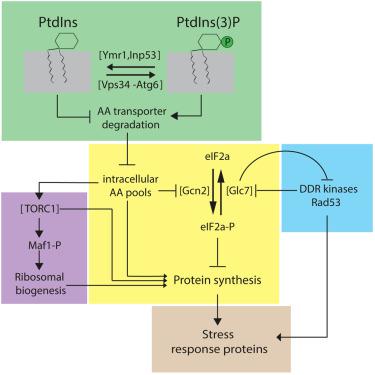Developmental Cell ( IF 11.8 ) Pub Date : 2021-09-16 , DOI: 10.1016/j.devcel.2021.08.019 Arta Ajazi 1 , Christopher Bruhn 1 , Ghadeer Shubassi 2 , Chiara Lucca 1 , Elisa Ferrari 1 , Angela Cattaneo 3 , Angela Bachi 1 , Nicola Manfrini 4 , Stefano Biffo 4 , Emanuele Martini 1 , Saverio Minucci 5 , Claudio Vernieri 6 , Marco Foiani 7

|
Atg6Beclin 1 mediates autophagy and endosomal trafficking. We investigated how Atg6 influences replication stress. Combining genetic, genomic, metabolomic, and proteomic approaches, we found that the Vps34-Vps15-Atg6Beclin 1-Vps38UVRAG-phosphatydilinositol-3 phosphate (PtdIns(3)P) axis sensitizes cells to replication stress by favoring the degradation of plasma membrane amino acid (AA) transporters via endosomal trafficking and ESCRT proteins, while the PtdIns(3)P phosphatases Ymr1 and Inp53 promote survival to replication stress by reversing this process. An impaired AA uptake triggers activation of Gcn2, which attenuates protein synthesis by phosphorylating eIF2α. Mec1Atr-Rad53Chk1/Chk2 activation during replication stress further hinders translation efficiency by counteracting eIF2α dephosphorylation through Glc7PP1. AA shortage-induced hyperphosphorylation of eIF2α inhibits the synthesis of 65 stress response proteins, thus resulting in cell sensitization to replication stress, while TORC1 promotes cell survival. Our findings reveal an integrated network mediated by endosomal trafficking, translational control pathways, and checkpoint kinases linking AA availability to the response to replication stress.
中文翻译:

内体运输和 DNA 损伤检查点激酶通过调节氨基酸摄取和蛋白质合成来决定复制压力的生存
Atg6 Beclin 1介导自噬和内体运输。我们研究了 Atg6 如何影响复制压力。结合遗传、基因组、代谢组学和蛋白质组学方法,我们发现 Vps34-Vps15-Atg6 Beclin 1 -Vps38 UVRAG -phosphatydilinositol -3 磷酸盐 (PtdIns(3)P) 轴通过促进质膜降解来使细胞对复制应激敏感氨基酸 (AA) 转运蛋白通过内体运输和 ESCRT 蛋白,而 PtdIns(3)P 磷酸酶 Ymr1 和 Inp53 通过逆转这一过程来促进复制应激的存活。AA 摄取受损会触发 Gcn2 的激活,后者通过磷酸化 eIF2α 来减弱蛋白质合成。Mec1 Atr -Rad53 Chk1/Chk2复制应激期间的激活通过 Glc7 PP1抵消 eIF2α 去磷酸化,进一步阻碍了翻译效率。AA 短缺诱导的 eIF2α 过度磷酸化抑制 65 种应激反应蛋白的合成,从而导致细胞对复制应激敏感,而 TORC1 促进细胞存活。我们的研究结果揭示了一个由内体运输、翻译控制途径和检查点激酶介导的综合网络,将 AA 可用性与对复制压力的反应联系起来。



























 京公网安备 11010802027423号
京公网安备 11010802027423号